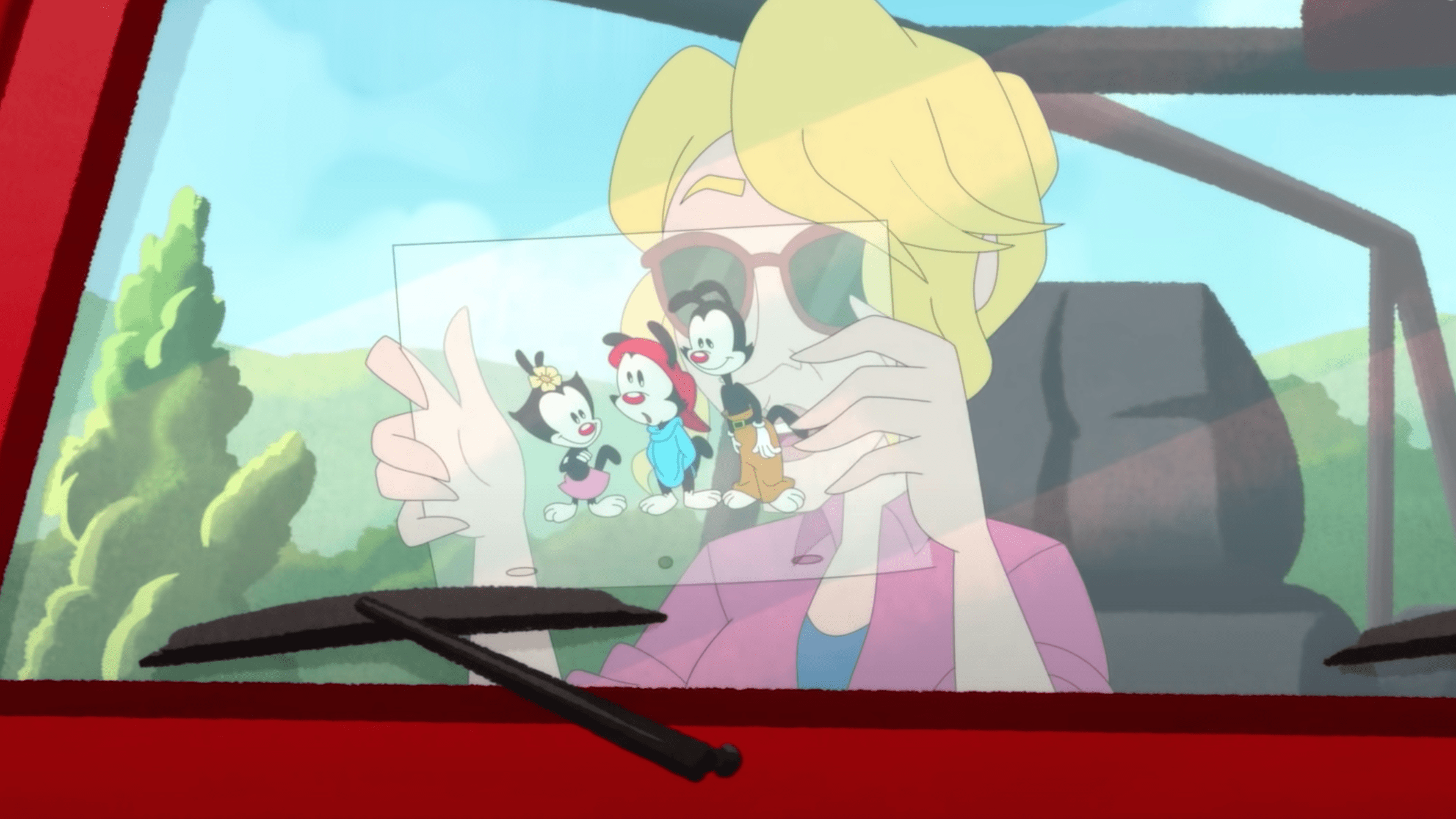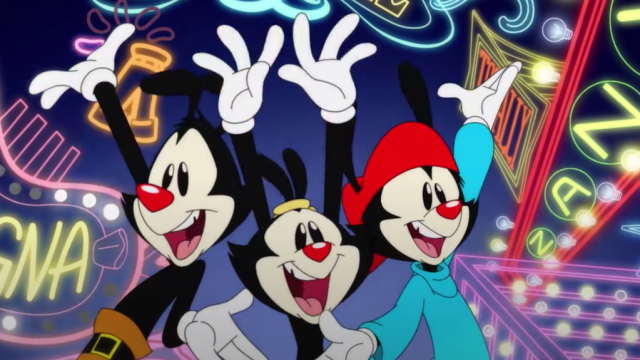Yakko, Wakko, and Dot are back — and they’re ready to turn 2020 upside down. Hulu has revived Animaniacs in an era where reboots are at an all-time high, giving these classic meta characters a window into modern cultural satire. But are ‘90s goofs still relevant two decades later?
Animaniacs picks up 22 years after the original ended with the Animaniacs magically back at the Warner Bros. studio lot, ready for more shenanigans. The world has changed since they left, but the show feels the same as before. It copies the animation style of the original, though the now-digital format gives the human characters an uncanny valley feel. The clean lines and brighter tones clash with the show’s purposefully ugly moments — like watching a toddler scream or the new Warner Bros. CEO laugh maniacally at the idea she’d ever eat refined sugar. (It reminded me a bit of Tom and Jerry: Willy Wonky and the Chocolate Factory, which is something I never want to say again.)
The Animaniacs themselves may be from a bygone era, but the show doesn’t forget that it’s taking place in 2020 — it spoofs modern culture, the concept of reboots, and even its own existence. One thing I appreciated was how the first episode was open about how it was written in 2018 so the modern references would already be dated (it did make the lack of TikTok feel extra noticeable). You can tell the writers, animators, and voice actors are having fun with Animaniacs — a series many of them either worked on back in the day or probably grew up with as kids. They’re not phoning it in, and for good reason: The Animaniacs has a legacy as being silly and irreverent while also very meta — back in a day when that type of humour wasn’t considered appropriate for kids.
But here’s my question: Where is the humour coming from, and who is it for? Having watched several episodes, I still have no idea who the target audience of the new Animaniacs is supposed to be. If I had to guess, well, it’s the people making it.
This Animaniacs is supposed to be both nostalgic and a new show for a new generation, but it doesn’t succeed at either.
The series fails in part because it didn’t update its nostalgia to make sense for fans who were kids then but are adults now. Instead, it’s stuck in the ‘90s. This presents itself in dated references to things like Seinfeld’s “The dingo ate your baby” and a Cold War-esque view of Russia. During times Animaniacs skews more modern, the satire is not “biting,” — as Dot herself claims in an early episode — it’s weak. At one point, the characters literally have to turn to the camera and explain that the episode’s storyline about multiplying “buns” (bunnies) was actually a commentary on guns. I’ve seen better stuff on TikTok — using the Animaniacs.
It also runs aground with some outdated cultural norms; I watched these episodes on the same day that AP Stylebook, the journalism Bible, put out a notice that terms like “insane,” “crazy,” and “nuts” should not be used in a derogatory way (they’re ableist against people with mental health issues, and it’s generally good practice to avoid them). Animaniacs uses those terms, a lot, much like the series did during its original run. Just fair warning if they make you uncomfortable.

The format of the reboot is largely the same as the original run, albeit without many of the standalone character sketches we got in the original. As a result, most of the five episodes I was able to preview included the main cartoon, a Pinky and the Brain segment, and another small skit also starring the Warners. This is kind of a big deal because the original show included many beloved side sketches and characters, like Buttons and Mindy, Mime Time, Goodfeathers, Colin, and others. Only one of the new episodes included a brand-new short in a similar vein, called Starbox and Cindy, that featured an alien trying to escape a little girl’s house. It had the most interesting animation choices by far and I loved how it featured an actual child’s voice, but it wasn’t an instant classic. It did leave me hoping to see more original shorts, though, as the episodes felt kind of repetitive without them.
Some of my frustration is centered around the show’s continued reverence of executive producer Steven Spielberg, whose “fingerprints” can be felt all over this series. This made sense in the ‘90s when Spielberg was the end-all-be-all of family-friendly entertainment, but his output has now broadened to include more grown-up fare. Still, the writers return to the same well expecting different results.
The series opens with a Jurassic Park parody portraying the Animaniacs as a revived species from the “Golden Era of Animation,” with Spielberg himself playing the role of the John Hammond overseer. Not only is it dated, given how big the Jurassic World franchise has gotten, but it also contains an unsettling message. On the surface, the “Golden Era” thing is a reference to the days of Mickey Mouse, which the Animaniacs were designed to mimic — but also comes across like a pat on the back to the “good old days” of ‘90s animation (ie the days of The Animaniacs). Except, here’s the thing: The past few decades have given us some of the most interesting animated shows we’ve seen in generations.
[referenced id=”1518283″ url=”https://gizmodo.com.au/2020/10/hellloooo-nurse-the-first-clip-from-hulus-animaniacs-reboot-is-a-return-to-form/” thumb=”https://gizmodo.com.au/wp-content/uploads/2020/10/12/hulu-animaniacs-300×170.jpg” title=”Hellloooo, Nurse! The First Clip From Hulu’s Animaniacs Reboot Is a Return to Form” excerpt=”Cartoons like this haven’t existed in the world for a long time. But here they are.”]
Steven Universe, Adventure Time, Avatar: The Last Airbender, Bojack Horseman, She-Ra and the Princesses of Power, Infinity Train, and so many others have made huge impacts on culture over the last several years. This is largely thanks to the growing push for diversity behind the scenes, something that was sorely lacking in the days of The Animaniacs. Instead of using satire to make commentary on all the ways animation has both changed and progressed in the years since the series ended, it instead chooses to be mean-spirited — insulting the modern animation style, “cute shows,” and anime. It’s all stuff people like for good reason. Given how often Spielberg has decried the changing media landscape, going so far as to try and prevent streaming movies from Oscar contention, it doesn’t surprise me that Animaniacs would take a similar angle of mockery instead of satire that fits.
I ended my binge session feeling conflicted. Was I expecting too much of the Animaniacs reboot? Maybe. Besides, I’m sure there are some folks who share the opinions depicted in it. To compare and contrast, I turned on Netflix’s Rocko’s Modern Life: Static Cling. Much like Hulu’s Animaniacs, Static Cling dumped Rocko into the modern world after spending decades in the vacuum-sealed safety blanket of the 1990s. That story dove into Rocko’s troubles adjusting to the 2010s, showing how desperate he was to have things go back to the way they were — and the moral of the story was that change is good, even if it’s not always easy. It was still goofy and had that trademark Rocko’s Modern Life style, making it fun for kids, but it had a message that worked better for the adults who grew up with it in the first place.
That’s not what we get with Animaniacs. It’s more about how the safety blanket is better and that we should be shaking our fists at the clouds because some people like Beyoncé or squid ink doughnuts made with cage-free eggs. If that’s your thing, that’s fine — there’s fun to be found in comfort, of course, especially during times like these. Although I do think that, much like Static Cling, this could’ve been better served as a movie or miniseries special.
I’m sure some kids will enjoy it, even though much of the humour won’t be for them (or sometimes even their parents). But you and I, we’re the adults now. We’ve grown up in this world and we know there are better ways to make fun of it. The Animaniacs have returned to a time they don’t like, but it’s not their fault. They’re not out of touch. No, it’s the children who are wrong.
Hulu’s Animaniacs debuts all 13 episodes of season one on November 20. The series has already been renewed for a second season.
